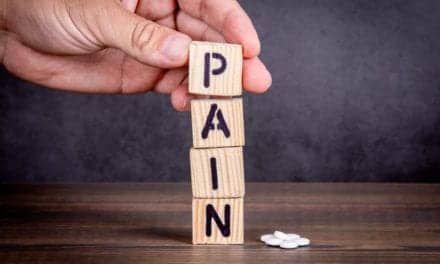To provide well-rounded solutions, therapists should maintain a wide scope of understanding about pain-management products beyond only those that offer reimbursement.
Most patients affected by pain symptoms don’t give a lot of thought to CPT codes and the intricacies of the insurance reimbursement process. Their primary concern is simply to find relief from pain in a fast and effective way. It is often part of a physical therapist’s job to help patients manage pain symptoms, yet not all the tools available to therapists that can effectively treat pain symptoms are covered by third-party payor reimbursement. Nonetheless, pain-management products that do not qualify for third-party payor reimbursement may offer a route to pain relief that fits a patient’s needs in a way that works particularly well for that individual. For this reason, therapists are wise to invest time in building a broad spectrum of understanding about pain-management modalities, including new and emerging technologies as well as the time-tested “go to” technologies.
Open to The Possibilities
Evidence-based medicine provides a valuable framework for the provision of care, yet some therapists may find technologies that currently lack a large base of study to support them—or have outpaced available research—can offer solid benefits. Therefore, new technologies or new approaches to treatment that produce therapeutic results without breaching professional ethics or being unsafe may be worth trying, even if third-party payors drag their feet on reimbursement.
Low-level laser therapy (LLLT) is an example of a technology that is often outside the coverage of insurance companies, yet offers good utilty in treating pain. Therapeutic laser treatment can reduce pain and inflammation, speed healing, and is designed to penetrate tissues deeper than ultrasound. Radial shockwave therapy (RST), too, offers an option for pain management for which patients often must pay out of pocket. Unlike electrotherapy, RST delivers a controlled mechanical insult to connective tissue that can stimulate healing, as well as prevent wear and tear to a therapists’s hands.
Electromedical Modalities
During the last 50 years, electromedical modalities have played a role in health care that most PTs are well-acquainted with. Among the long-standing technologies used for therapeutic pain relief are e-stim and ultrasound. Recently, however, the market has seen the appearance of electromedical devices that deliver several types of treatment from a single unit. Examples include the Winner CM EVO from Chattanooga, Tenn-based Richmar, and the UltraTENS II Ultrasound and TENS combination unit from Roscoe Medical, Strongsville, Ohio. Combination units offer the convenience of several types of electromedical treatment in a single unit, which can help make them a favorite among some therapists.
Whether a device provides only one function, or combines multiple functions, many PTs have preferences for specific types of electrotherapy equipment. That preference may be rooted in variables such as how the PT feels the device works for him or her, the settings in which the PT works, and the type of patients the PT treats. Though reimbursement is uneven across the spectrum of electromedical modalities, it is nonetheless a good “investment” for a therapist to keep up-to-date on the science behind new equipment and new modalities.
For example, LLLT is a modality that can provide effective treatment, yet generally lacks payor reimbursement. Therapists can nonetheless offer LLLT services as effective pain relief as part of cash-pay programs. The therapeutic effects of laser devices, such as the Apollo Class IV Cold Lasers available from PHS Therapeutics, a division of Pivotal Health Solutions, Watertown, SD, are designed to reduce pain and inflammation and stimulate healing. Another type of LLLT device, Richmar’s Winner CM EVO hybrid unit, also provides therapeutic pain relief and can be equipped with laser, ultrasound, and e-stim. The multimodality Vectra NEO from Chattanooga, a DJO Global Company, Vista, Calif, provides similar options.
Electromedical modalities such as e-stim and TENS are mature technologies that remain popular. Devices come in many configurations and require the use of electrodes which, by extension, requires the use of electrode gel. Among the manufacturers of electrode gel is Parker Labs, Fairfield, NJ, which offers Spectra 360 Electrode Gel in a formula made to be bacteriostatic and salt-free.
Topicals and Hot/Cold Therapy
In the case of topical analgesics, such as the natural pain-relieving gels offered by Albuquerque, NM-based Sombra, and Moab, Utah-headquartered Sore No More, the counterirritant effect distracts the pain signals of the original injury by overriding them via the Gate Control Theory. Cold therapy that uses ice massage and cold packs, such as Elastogel from North Kansas City, Mo-based Southwest Technologies, are known to cause vasoconstriction and reduce swelling, which makes them effective products for pain relief. The mechanism behind the pain-relieving sensation of cold therapy is not entirely clear, yet its effectiveness is widely recognized. Ice, in fact, is included as one of the components in the RICE (rest, ice, compression, elevation) protocol for soft-tissue injuries.
Emerging Pain-Management Technologies
Two other pain-management technologies physical therapists will want to know about are ultrasound and pulsed electromagnetic field (PEMF). Cryoultrasound combines the effects of cold therapy, and ultrasound is reported to be superior to the use of ultrasound only or to CO2 laser for the reduction of pain and inflammation in sports injuries.2 Studies associated with this technology have been conducted primarily on athletes.
The larger than normal sound head on cryoultrasound devices is designed to be rapidly cooled down to near freezing temperature. The cooling function is performed by a refrigeration system built into the device. The sound head is engineered to deliver from 0.0 to 3 W/cm2 either continuous or pulsed at 50 Hz or 100 Hz for a duration of 10 to 30 minutes.
The deep heating effect of the ultrasound is minimized by the cold effect. Initially, there is a strong vasoconstriction at the skin level, followed by vasodilatation at the skin level with a concurrent vasoconstriction at the deeper muscle level. This makes the muscle/tendon/ligament more dense, which in turn augments the responsiveness of these tissues to the mechanical effects of ultrasound.2 Among the current primary users of this type of equipment are sports club therapy departments and university athletic departments.
Ultrasound at much lower intensities—such as <100 mW/cm2—can accelerate healing of fresh fractures. Another beneficial effect is via upregulating binding of calcium with calmodulin, which leads to a transduction pathway targeting growth factors.3
Therapeutic Effect of Pulsed ElectroMagnetic Field
PEMF technologies can be used to treat soft-tissue injuries, though therapists may be less familiar with this technology than other modalities. A wealth of published lab and clinical research is available to clinicians today that provides the scientific basis for the action of PEMF. Among the topics addressed by recent review are transduction pathways and safety.4 The authors of that review concluded that PEMF has no known side effects for the noninvasive and nonpharmacologic management of postoperative pain and swelling.4
The market currently offers several types of PEMF devices, yet therapists should be sure to confirm claims about safety, effectiveness, and cost. A battery-powered device manufactured by Bioelectronics Corp, Frederick, Md, offers this type of technology for the physical therapy market. It is designed to be small, flexible, light, and easy for patients to wear outside of the clinic. Furthermore, it is engineered to be
user-friendly and affordable, and to integrate well with other components of a physical therapy program.
Application and Benefits
The antenna of the PEMF device is designed to be placed and secured over the area of injured tissue. Since the signal can penetrate through bandages, dressings, and clothing, skin contact is not required. The unit is designed to be left on for hours or days, and patients who wear the product should feel nothing. The signal can produce a biological effect even at 10 cm of tissue depth. There are no strict protocols for treatment, and off-label use among various medical specialties has been reported.
Pain Relief Patches
Wearable patches have become established as a convenient option for pain management that patients can wear inside or outside the physical therapy clinic. Among the latest of these types of products to enter the market is the LidoFlex, manufactured by Richmar. The LidoFlex is formulated to have a high concentration of lidocaine that does not require a prescription and is designed to provide area-specific pain relief.
The ActivaPatch and Trivarion Butterfly are additional types of pain-relieving patches available to the physical therapy market through Gilroy, Calif-based ActivaTek Inc.
Therapists have an array of options to manage pain. By investing in developing an understanding about the full spectrum of solutions, they can provide effective treatment from an informed perspective. PTP
Frank Long is editorial director of Physical Therapy Products. For more information, contact [email protected].
References
1. Hodges PW, Cholewicki J, van Dieen J, Eds. Spinal Control: Rehabilitation of Back Pain. Edinburgh: Elsevier; 2013:59-74, 243-310.
2. Costantino C, Pogliacomi F, Varienti E. Cryoultrasound therapy and tendonitis in athletes: A comparative evaluation versus laser CO2 and T.E.CA.R. Therapy. Acta Bio Med. 2005;76:37-41.
3. Barns F, Greenbaum B, Eds. Handbook of Biological Effects of Electromagnetic Fields. 3rd ed. Boca Raton, Fla: CRC Press; 2006:351-411.
4. Strauch B, Herman C, Dabb R, Ignarro LJ, Pilla AA. Evidence-based use of pulsed electromagnetic field therapy in clinical plastic surgery. Aesthetic Surg J. 2009;29:135-143.
5. Selected references available at www.msteinpt.com/references




